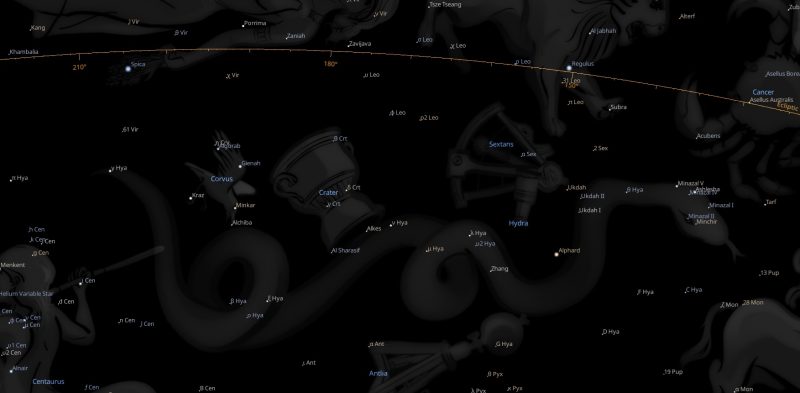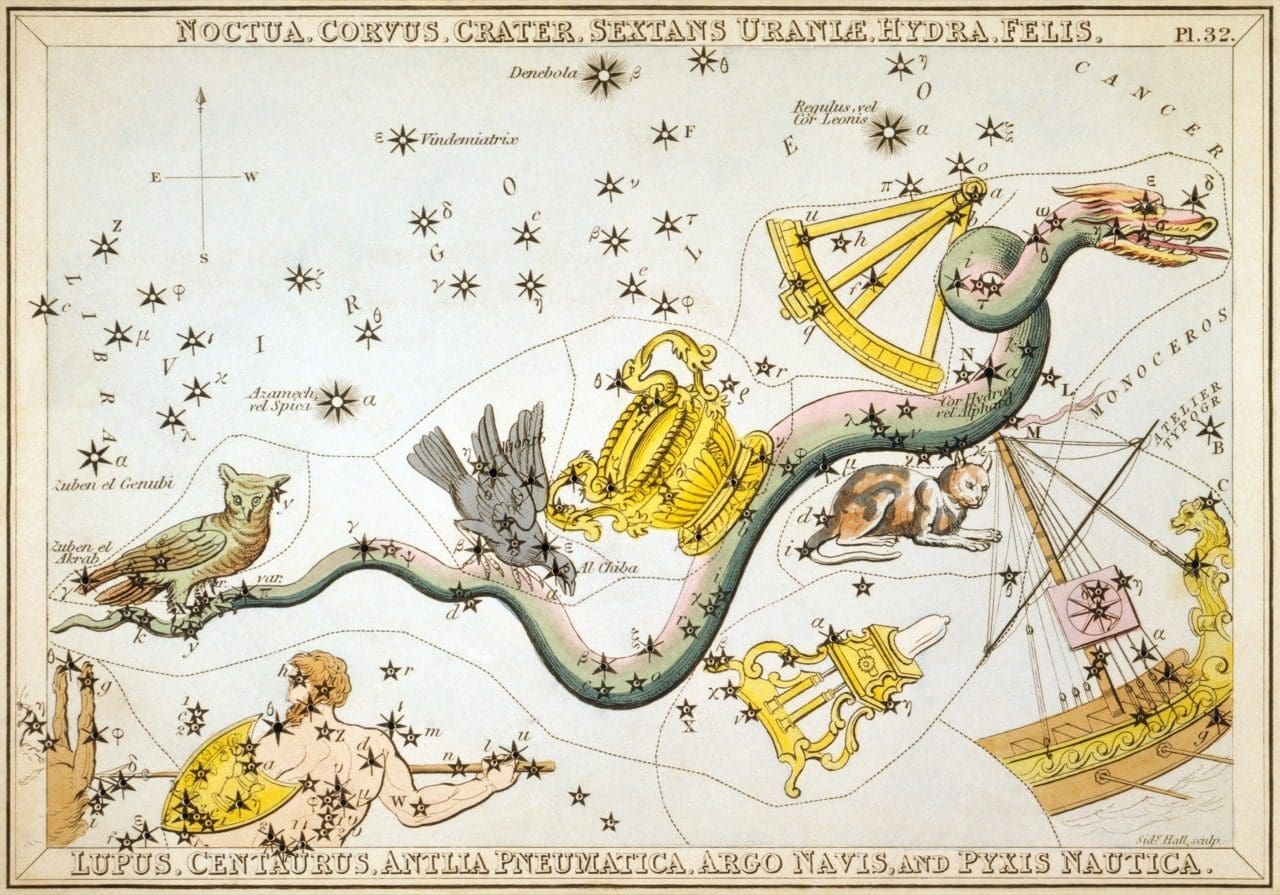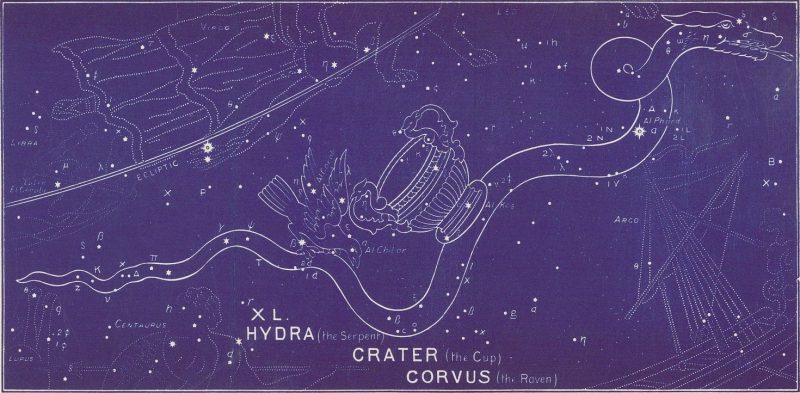FIXED STARS: Major Stars | 1000+ Stars | Constellations | About
Constellation Hydra, the Water Snake, is a southern constellation bordering Libra, Virgo, Corvus, Crater, Sextans, Leo, Cancer, Canis Minor, Monoceros, Puppis, Pyxis, Antlia, Centaurus and the obsolete constellations Argo Navis, Felis and Noctua.Hydra is one of the 48 constellations listed by Ptolemy in the 2nd century and remains one of the 88 modern constellations. It spans 90 degrees of the zodiac in the Sign of Leo, Virgo, Libra and Scorpio.
Hyrda Constellation is the Female Water Snake, bigger and older than Hydrus Constellation, the Male Water Snake formed in 1597.
Abbreviation: Hya
Genitive: Hydrae
Hydra Constellation Stars
| 2000 | 2050 | Star | Name | Sp. Class | Mag. | Orb |
|---|---|---|---|---|---|---|
| 10♌19 | 11♌01 | δ Hya | Minazal I | A1 | 4.14 | 1°20′ |
| 11♌13 | 11♌55 | σ Hya | Minchir | K2 | 4.45 | 1°10′ |
| 12♌19 | 13♌01 | η Hya | Minazal II | B3 | 4.30 | 1°10′ |
| 12♌21 | 13♌03 | ε Hya | Ashlesha | G0 | 3.38 | 1°40′ |
| 12♌55 | 13♌37 | ρ Hya | Minazal IV | A0 | 4.35 | 1°10′ |
| 14♌35 | 15♌17 | ζ Hya | Minazal V | G8 | 3.11 | 1°50′ |
| 20♌18 | 21♌00 | θ Hya | B9 | 3.89 | 1°30′ | |
| 25♌35 | 26♌17 | τ1 Hya | Ukdah I | F6 | 4.59 | 1°10′ |
| 25♌45 | 15♌27 | τ2 Hya | Ukdah II | A3 | 4.54 | 1°10′ |
| 26♌15 | 26♌57 | HD78702 | A0 | 5.73 | 1°00′ | |
| 27♌17 | 27♌59 | α Hya | Alphard | K3 | 1.99 | 2°20′ |
| 27♌39 | 28♌21 | ι Hya | Ukdah | K3 | 3.90 | 1°30′ |
| 28♌02 | 28♌44 | A Hya | Ukdah III | K1 | 5.56 | 1°00′ |
| 02♍41 | 03♍23 | κ Hya | Al Sharasif I | B4 | 5.07 | 1°00′ |
| 02♍48 | 03♍30 | HD82573 | A4 | 5.74 | 1°00′ | |
| 02♍50 | 03♍32 | G Hya | K1 | 4.72 | 1°00′ | |
| 03♍48 | 04♍30 | HD82734 | K0 | 5.02 | 1°00′ | |
| 05♍42 | 06♍24 | υ1 Hya | Zhang | G6 | 4.11 | 1°20′ |
| 07♍03 | 07♍45 | I Hya | B5 | 4.76 | 1°00′ | |
| 07♍27 | 08♍04 | HD84117 | G0 | 4.93 | 1°00′ | |
| 08♍21 | 09♍03 | HD85951 | Felis | K5 | 4.94 | 1°00′ |
| 09♍22 | 10♍04 | λ Hya | K0 | 3.61 | 1°40′ | |
| 15♍02 | 15♍44 | μ Hya | K4 | 3.83 | 1°30′ | |
| 20♍22 | 21♍04 | ν Hya | Sherasiph | K0 | 3.11 | 1°50′ |
| 07♎59 | 08♎41 | ξ Hya | G8 | 3.54 | 1°40′ | |
| 13♎27 | 14♎09 | β Hya | B9 | 4.29 | 1°20′ | |
| 27♎01 | 27♎43 | γ Hya | Dhanab al Shudja | G8 | 2.99 | 1°50′ |
| 08♏37 | 09♏19 | π Hya | K2 | 3.25 | 1°50′ | |
| 16♏47 | 17♏29 | m Hya | Al Janah | F0 | 5.15 | 1°00′ |
| 17♏08 | 17♏50 | 55 Hya | Vigilis Borealis | B9 | 5.61 | 1°00′ |
| 17♏22 | 18♏04 | 56 Hya | Cor Noctua | G8 | 5.23 | 1°00′ |
| 17♏35 | 18♏17 | 57 Hya | Vigilis Australis | B9 | 5.76 | 1°00′ |
| 18♏29 | 19♏11 | E Hya | Al Corni | K3 | 4.42 | 1°00′ |
| 20♏11 | 20♏53 | 59 Hya | A6 | 5.65 | 1°00′ |
m, E, 55, 56, 57, and 59 of Hydra belonged to the obsolete constellation Noctua the Owl.
Hydra Astrology
Robson
Legend. This constellation represents the snake picked up and taken to Apollo by the crow (see CORVUS).
Influence. According to Ptolemy the bright stars are like Saturn and Venus. It is said to give an emotional and passionate nature, threatened by great troubles, and to cause some interest in shipping.
Magical. Gives wisdom and rishes, and resists poisons. [1]
Noonan
Today called Hydra (Hya), this constellation is similar in nature to itsd northern counterpart, Draco. This group of stars also affects the sea and shipping, however, in this latter instance the indications are for difficulties and even tragedy. [2]
Allen
Hydra, the Water-snake… may be classed among the Argonautic constellations, as it was said to represent the Dragon of Aetes.
Its stars are now well defined under this single title, but anciently were described, with their riders Corvus and Crater.
Other names, also used for the northern Dragon, have been Draco, Asiua, and Asuia, or Asvia, which Bayer referred to as ἀσούγια non ἀσβία; but these are not Greek words, and doubtless are from Al Shujāʽ, the Snake, transformed, as only the late mediaeval astronomical writers and their immediate successors could transform classical and Arabic terms into their Low Latin and Greek; Chilmead wrote it Alsugahh. Still another conception and title may be seen in the Arabo-Latin Almagest’s Stellatio Ydre: et est species serpentium; et jam nominatur Asiua. secur᾽; where the last word, if an abbreviation for securis, “ax,” seems not inappropriate when taking the western half of Hydra for a somewhat crooked handle, and Corvus for the ax-head. The Asina, or She Ass, which La Lande mentioned, is probably a continuation of some early type error in the barbarous Asiua.
Its representation has generally been as we have it, but the Hyginus of 1488 added a tree in whose branches the Hydra’s head is resting; probably a recollection of the dragon that guarded the apple-trees of the Hesperides, although this duty really belonged to our Draco; and at times it has been shown as three-headed. Map-makers have always figured it in its present form, the Cup resting midway on its back, with the Raven pecking at one of its folds; Hydra preventing the latter’s access to the Cup in punishment for its tattling about Coronis; or for its delay in Apollo’s service. The minor constellation Turdus, or Noctua, only recently has been added to it.
The 7th sieu, Lieu, a Willow Branch, or Liu, a Circular Garland, — was the creature’s head, 15° south of Praesaepe, δ being the determinant, and formed the beak of the Red Bird; it governed the planets and was worshiped at festivals of the summer solstice as an emblem of immortality.
Here, too, was the 7th nakshatra, Āçleshā, or Āçreshā, the Embracer, figured as a Wheel, with Sarpas, the Serpents, as presiding divinities; ε marking the junction with the nakshatra Maghā.
The 8th sieu, Sing, a Star, anciently Tah, was formed by α, σ, and τ, with others smaller lying near them, α being the determinant. This asterism constituted the neck of the Red Bird, and, Edkins asserts, was also known as the Seven Stars.
The 9th sieu consisted of κ, υ1, υ2, λ, μ, φ, and another unascertained, and was called Chang or Tchang, a Drawn Bow, — Brown says “anciently Tjung, the Archer,” — υ1 being the determinant; the god Chang using this bow to slay the Sky Dog, our Crater. The stars between Corvus and Crater were Kien Mun, and those between γ Hydrae and Spica of the Virgin were Tien Mun, Heaven’s Gate. These lie beyond the outlines of the Virgin’s robe on the Heis map, but on Burritt’s are included in the tip of her left wing.
Hydra is supposed to be the snake shown on a uranographic stone from the Euphrates, of 1200 B.C., “identified with the source of the fountains of the great deep,” and one of the several sky symbols of the great dragon Tiāmat. Certain stars near, or perhaps in the tip of Hydra’s tail and in Libra, seem to have been the Akkadian En‑te-na-mas‑luv, or En‑te-na-mas‑mur, the Assyrian Etsen-tsiri, the Tail-tip.
Theon said that the Egyptians considered it the sky representative of the Nile, and gave it their name for that river.
The constellation cannot be seen in its entirety till Crater is on the meridian. Argelander enumerates in it 75 stars; Heis, 153.
For an unknown period its winding course symbolized that of the moon; hence the latter’s nodes are called the Dragon’s Head and Tail. When a comet was in them poison was thought to be scattered by it over the world; but these fanciful ideas are now associated with Draco. [3]
Bullinger
After Al Sufi’s day, in our 10th century, the figure was much lengthened, and now stretches for nearly 95° in a winding course from Cancer to Scorpius; this well agreeing with the fable of its immense marine prototype, the Scandinavian Kraken. Conrad Gesner, the 16th-century naturalist, gave an illustration of this in its apparently successful attack upon the ship Argo. [1]
It is pictured as the female serpent (Hydra), the mother and author of all evil. Hydra has the significant meaning, he is abhorred! It is an immense constellation extending for above 100 degrees from east to west, beneath the Virgin, the Lion, and the Crab. It is composed of 60 stars; one of the 2nd magnitude, three of the 3rd, twelve of the 4th, etc.
The brightest star, α (in the heart of the Serpent), is sometimes called by the moderns Cor Hydrae on that account. Its ancient name is Al Phard (Arabic), which means the separated, put away. Another is called Al Drian, the abhorred. Another star is named Minchar al Sugia, the piercing of the deceiver. [4]
References
- Fixed Stars and Constellations in Astrology, Vivian E. Robson, 1923, p.47, 231.
- Fixed Stars and Judicial Astrology, George Noonan, 1990, p.70.
- Star Names: Their Lore and Meaning, Richard H. Allen, 1889, p.246-250.
- The Witness of the Stars, E. W. Bullinger, 1893, HYDRA (the Serpent).


